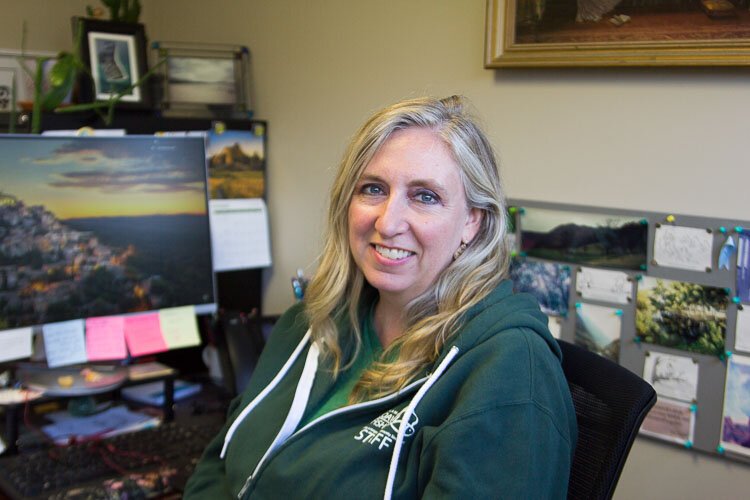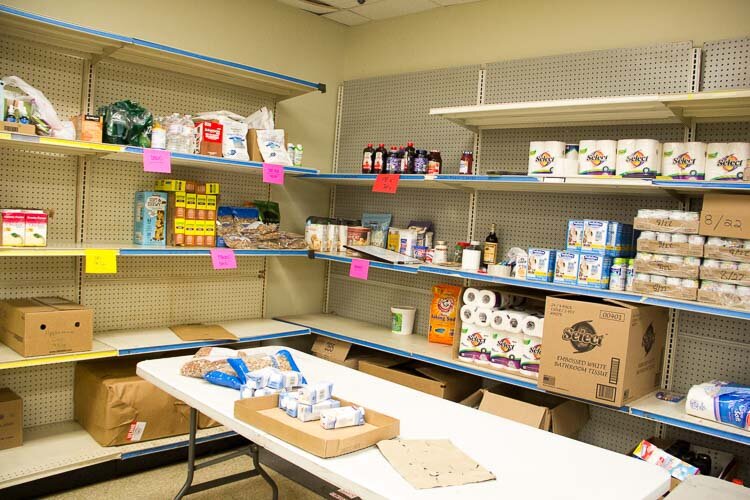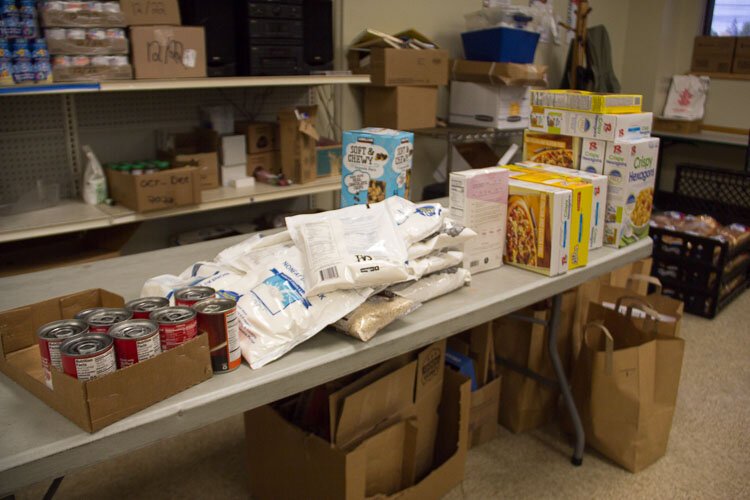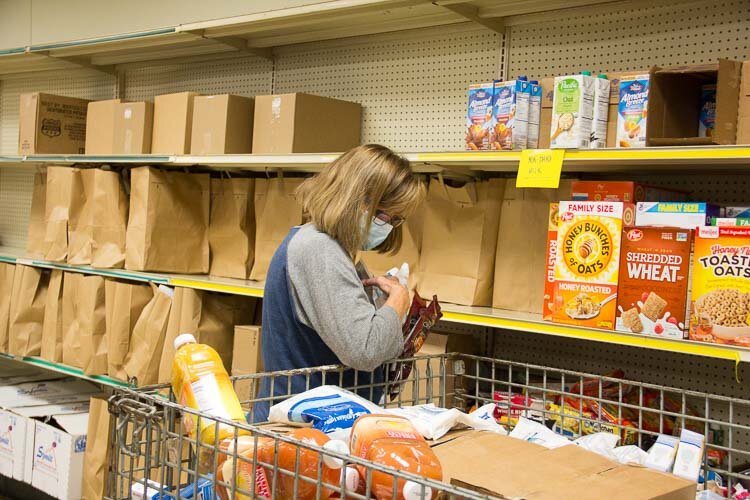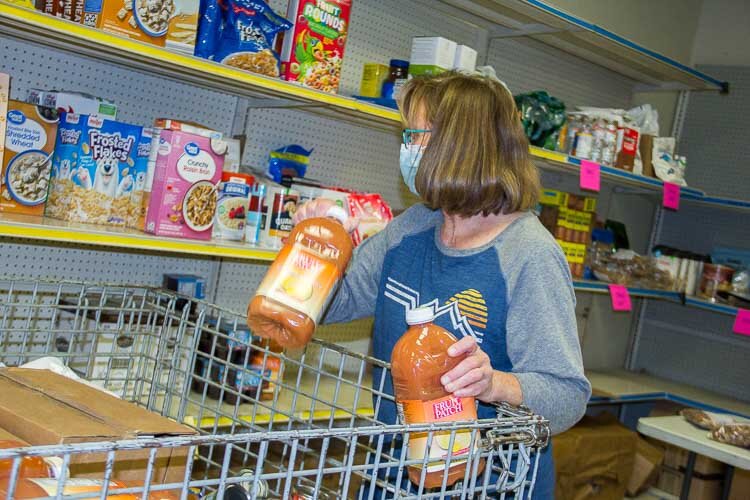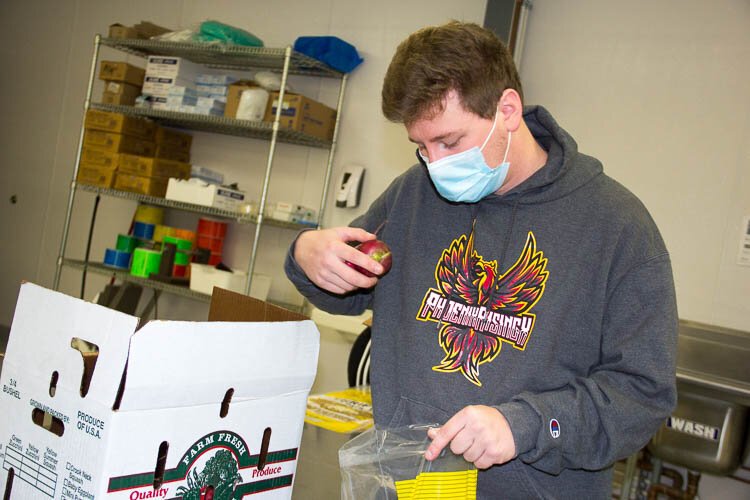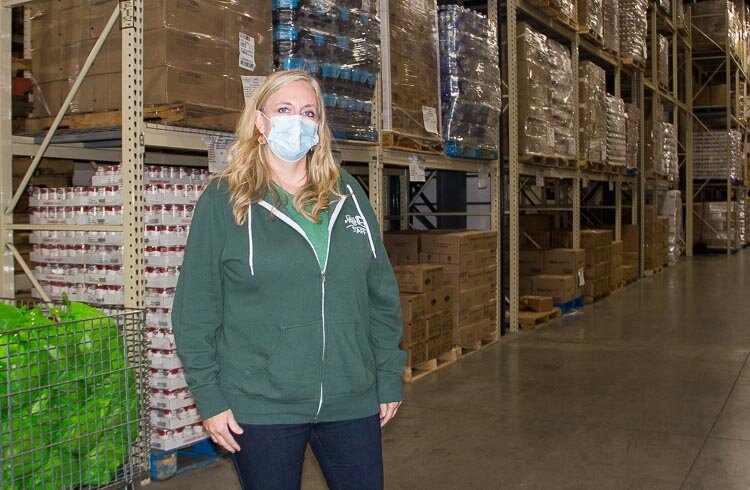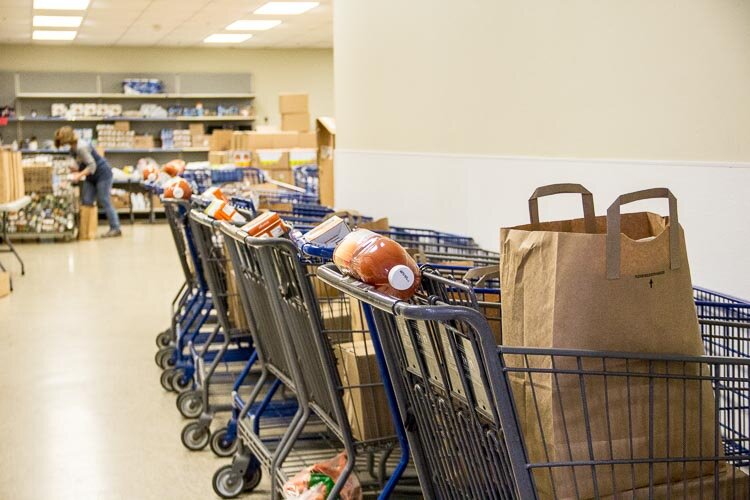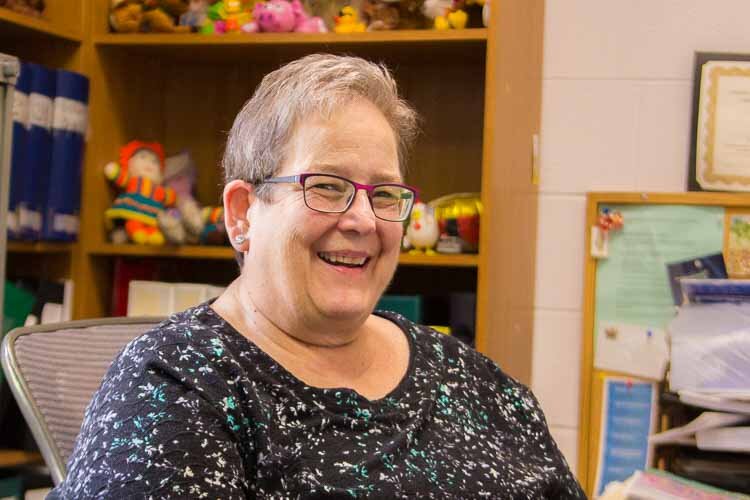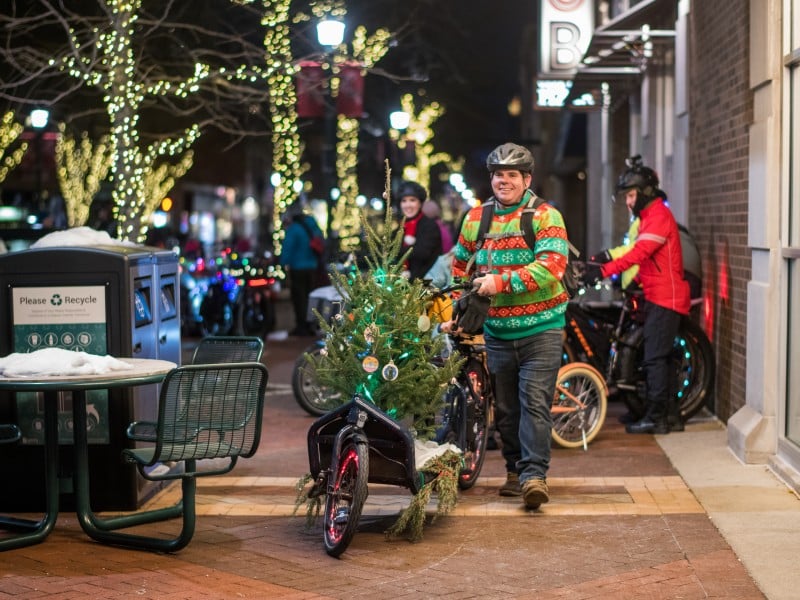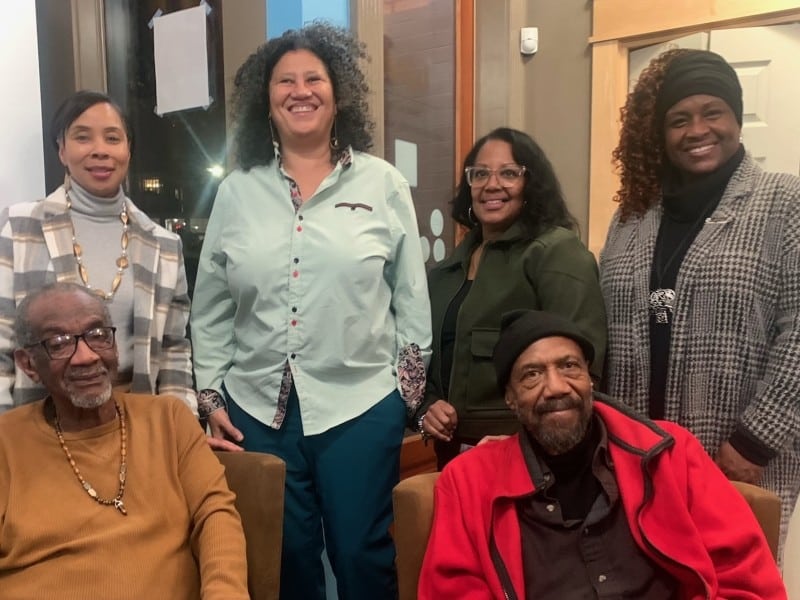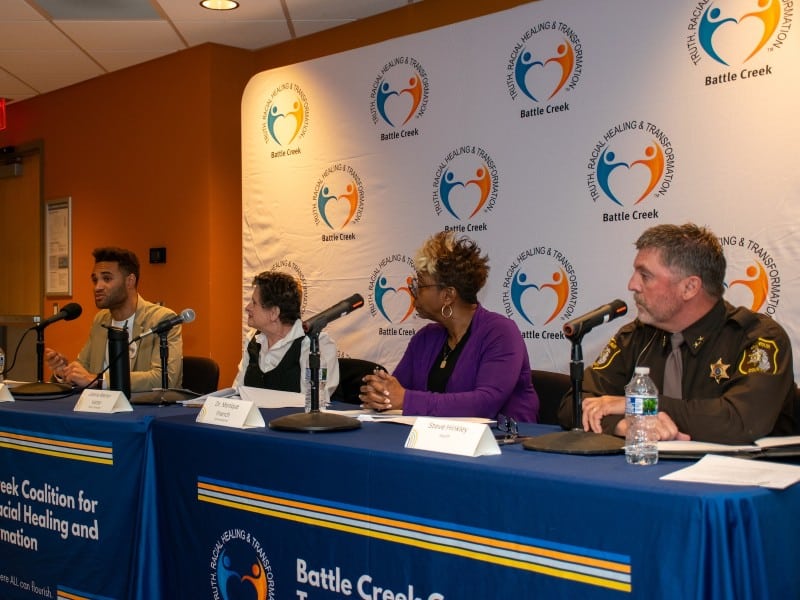Let’s talk: Rural and urban service organizations discuss common concerns around food insecurity
Local food banks that serve both rural and urban constituencies are being hit hard by fluctuations caused by the pandemic. In 2020, donation sources closed, food drives stopped. In 2021, food prices rose, deliveries slowed, food was being diverted to commercial use as restaurants and other businesses opened. Nonprofits' needs continue to be great.
Editor’s note: Second Wave is fostering discussions between people working on issues affecting both rural and urban Kalamazoo County. This is the second part in the series and focuses on the challenges of assuring there are green spaces in urban and rural communities.
Food pantries are accustomed to variations in their work feeding people in Kalamazoo County.
Late summer through early fall, they tend to get a flood of squash, zucchini, and tomatoes. Mary Gustas, executive director of the Comstock Community Center, says they often get donations from gardeners. Their biggest contributor, she says, “is so funny, because he loves to garden, but he doesn’t eat anything he grows.” So he trucks in a load of veggies to help feed the hungry.
This can be good for some, confounding for others — not everyone knows what to do with a spaghetti squash or zucchini. Often their clients’ food habits, cultural traditions, or lack of access to a full kitchen keep pantries on their toes to meet people’s needs.
But 2020-2021’s fluctuations in food supplies, shipping issues, and price increases are forcing food pantries to make continuous adjustments.
We spoke with some of the people working to feed people in the rural and urban areas of Kalamazoo County about the stresses their work has faced during the pandemic.

Takeaways:
Local food banks are being hit hard by fluctuations caused by the pandemic. In 2020, donation sources closed, food drives stopped. In 2021, food prices rose, deliveries slowed, food was being diverted to commercial use as restaurants and other businesses opened. Nonprofits’ needs continue to be great.
There’s been an increase in governmental benefits to help feed the hungry, but local food banks have to catch those who fall through the cracks, such as the homeless, seniors, people facing financial emergencies, people who can’t wait for benefits to arrive.
Food banks do what they can to meet the needs of people. Food pantries provide a shopping-like experience. Food box deliveries visit communities to reach people who may not be able to get to their nearest pantry.
Seniors face their own challenges, like an inability to get groceries, difficulties with preparing their own meals. Meals on Wheels helps keep them fed.
Food banks try their best to provide healthy nutrition. But what people eat is a matter of culture, of habits, of necessity. Some people may not know how to cook with fresh vegetables, and others may not have access to a kitchen.
Below is a transcript, edited for length and clarity, of a one-hour online discussion with five people who work to get food to those in need in both urban and rural Kalamazoo County.
Speakers:
Greta Faworski, associate director of Kalamazoo Loaves and Fishes.
Abbey Finn, director of operations at Milestone Senior Services, formerly Senior Services, who are behind local Meals on Wheels.
Mary Gustas and Comstock Community Center’s community outreach director, Diana Reynolds.
Drew Johnson, executive director of South County Community Services.
Second Wave: First, a general question: What seems to help your mission?
Reynolds: “Just being available. Getting the word out that we’re open. That’s the biggest thing. Sometimes just word-of-mouth. A neighbor will tell a neighbor, ‘Hey! They have food down there.’ We’ve been getting several seniors, new clients, just by word of mouth. (They’re not likely to hear about pantries on the local news or find it online.)”

SW: People might not have internet access, or even TV or a radio. And if they have access to local media, local news media doesn’t cover food pantries or other services a whole lot. Maybe once every Thanksgiving. So, how do you get the word out?
Faworski: “Part of it is working with partner organizations, because different organizations may encounter people dealing with housing, dealing with childcare, and they find through those conversations that food insecurity is one of their issues. Having those partnerships, making sure other agencies are aware of what we offer, where there are resources, is really important. Because whoever has that first conversation with somebody is often the one who’s going to navigate them towards other avenues. Word of mouth is also a big part of it as well. You can spend a lot on advertising and not really touch the people who need to hear it.”
Johnson: “We, like everybody else, advertise in many different places. We’ve got stuff on social media, we’ve got stuff in many different papers, we work a lot with partner organizations. I think we get little dribbles from each one of those, and each one of those I think is important for us to do, because we don’t want to leave anyone out…. You have to be everywhere and connecting with everybody.”
“For us, consistency has been a big thing. We noticed quite a drop off when we changed some services around during COVID…. It’s been an important thing to be offering the food at the same hours, the same days, every week. I think that’s helpful for people…. And Loaves and Fishes, Greta might be able to speak to that a little more, because I know they have some varied models where some of them are every day of the week, and some are scheduled (when) there’s food available.”
Faworski “I think having a variety of access points is really important, not only geographically, but time of day…. That someone, if they’re on one side of town, they can swing by and get something when they’re there….”
“We have a call center, and have lots of people call the call center, but we get just as many people who reach out via Facebook Messenger, and our info line, because maybe they’re on a break at work and that’s the only time they have to shoot a quick message to say, ‘I need food.’… Removing barriers is the biggest thing.”
SW: How has the situation been with COVID? It sounds like in 2020 there was increased demand, but that dropped this year?
Johnson: “It depends for us… The story across the board has been, there is just a huge increase in need, there is also a huge increase in people helping out…. Sometimes it balances out, but it seemed like a delicate ecosystem that was thrown out of whack two years ago. Sometimes there’s plenty available, sometimes there’s not, and it doesn’t match up as much as it used to.”

Reynolds: “Our pantry has been down (in use) as far as family-wise, because of EBT and all that extra money. But our homeless population and our seniors have been steadfast, if not increasing. We are also promoting the commodity program much more, and I try to catch those folks when they come to the pantry, to get them signed up because they aren’t getting hundreds of dollars in food stamps, and prices are going up. They are really grateful — I get the most grateful population that we serve. Families are down, but seniors, homeless, single adults (with) no children are definitely up.”
Faworski: “That’s similar to what we’ve seen because a lot of individuals didn’t fall into those pockets where they got all of those benefits. It’s been such a rollercoaster in the past year and a half. There’ve been spikes in needs and lulls, and it all corresponds to influxes of governmental benefits. We saw such a huge influx those first four months of COVID. When people started getting stimulus, and especially when schools started giving pandemic EBT cards, there were a lot of additional dollars…. We’ve started to see an increase (in demand), as we’ve expected, as these things have started to ebb away. We had about a 30% increase in serves from August to September, and we expect to see that as long as people are no longer getting as many benefits. But there are lots of families who didn’t have that.”
“We saw an increase with the seniors — particularly one of the things we changed during COVID was a home delivery program. We launched it right away, worrying about access points. We just found a lot of seniors who wouldn’t be able to get out no matter how many pantries existed. Even if they had a car they couldn’t drive because of vision issues or whatever. It’s just an ever-changing landscape that I don’t think has balanced out yet.”
Gustas: “How many pantries closed permanently because of COVID? I know there were some.”
Faworski: “I would say about five for sure. Before COVID we had 30 pantries in the network. Ten of those were school-based, so we couldn’t open those until this past September, and all of those are open again. Churches, in general, are also having a hard time. Some of them haven’t gone back to actual face-to-face congregational meetings… Some volunteers took it as an opportunity to bow out, and that’s okay. And there are new things that’ve come along, we’ve gotten a couple new pantries.”
Gustas: “We were open during the entire period. I know that Loaves and Fishes were doing a distribution at the main location on Portage (Street). And we kept our location open as a choice pantry. Our numbers went up to begin with, and they kind of mellowed out again. But it’s a walk-in basis…. It’s picked up a little bit lately, and I think that’s because EBT cards have gone back to normal levels. So we’ll see an increase again….”
Reynolds: “I’m sure it will pick up again, closer to the holidays especially.”
SW: Secretary of Agriculture Tom Vilsack says that at the height of the pandemic, 14% of American adults were receiving SNAP benefits, and that’s down to 8% now. And this month, the Biden administration has increased SNAP benefits 25%. You’re trying to catch all those people not able to get these benefits, correct?
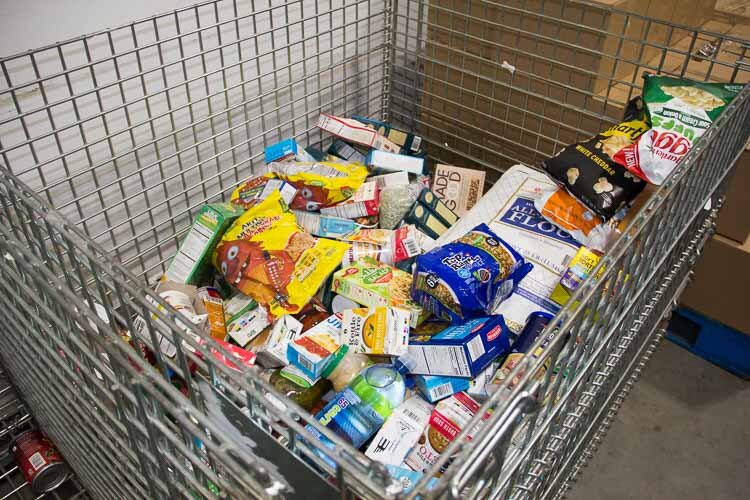
Faworski: “There are so many factors why someone might need food assistance. They may be getting those benefits, but they have huge expenses in other ways that take any of their remaining dollars. Some of it is situational. We’ve talked to a lot of people who are in transition as they’re moving, or they just need help for a month or two, and then they’re fine. It’s constantly changing who is facing food insecurity.”
“But the thing about the increase in the SNAP benefits, the 25% increase, in many ways it’s a wash because food prices are so much higher… When you look at it it seems like a lot, and it is, they’re looking at keeping it higher, but the prices are so much higher, in general, it’s a wash for many families.”
(Finn of Milestone Senior Services logs on.)
SW: Abby, are seniors getting help? What are their needs in food assistance?
Finn: “Sometimes the biggest challenge with our seniors is not just in attaining the food, but the preparation of the food. Standing to cook the meals. Sometimes the things they receive just don’t work for them and their needs and lifestyle. We’ve seen a huge increase in the demand for the (Meals on Wheels) packaged and prepared food. That way it keeps them from eating those unhealthy convenience items. So with the Meals on Wheels, it’s something that they can easily heat up, or eat right when it arrives. We like to supplement with pantry food when we can, but we’ve found that some of them don’t remember to prepare it, unfortunately.”
SW: It seems there are different issues with different people. We talked with Mary before about homeless people who show up at the Comstock pantry. All she can give them is something in a can, since they have no kitchen, no cooking or eating utensils, they have nothing. Do you all face situations like that?
Johnson: “Absolutely. One of the things that have come up… is trying to reduce barriers for people. If you don’t have an address to apply through the state for food stamp benefits, then it can be harder. If you’re a senior, and it’s hard for you to use a computer, then that’s harder. There are all these ways to make it more difficult. So I feel our role is in filling those gaps between those services. We try to help people get connected. We will help people with DHHS applications, doing food stamps and different forms of emergency financial assistance when we can.”
“…That’s what I think a lot of these local nonprofits do, is try to keep their barriers down so everybody can have equal access to them.”
SW: What about some sort of food education? It’s difficult enough to get food to people to start with, but there’s nutrition….
(Gustas and Reynolds ask each other about someone from Van Buren who’d presented a program on food education in Comstock.)
Gustas: “They come in and they’ll provide educational programs, how to make a meal for one, or how to make a meal for two, using things that are available in the pantry. Pre-COVID, they were more available to do those training programs.”
Johnson: “Is that Project LEAN?
Gustas: “That’s one of them…. But we didn’t have that many people who would come in and go through the program. If we had six people who would come in, then surprise! And it’s free. And they get to taste the food. It’s really weird that, here’s an opportunity to learn how to cook and feed your family. We have a couple of our volunteers in our pantry that like to give advice as to, ‘here, you should get this, and then you can make this, this and this.’ But young families, they don’t know how to cook. ‘What do you have that’s microwavable?’ I don’t think they know how to use a stove.”
SW: Food is habit, it’s culture, it’s a lot more than just what we need to eat to survive. It sounds like there are differences in what people in different parts of the county eat. Mary has told us about hunters who used to donate venison to the Comstock pantry. She said that people in the country knew what to do with it; people in the city, they refused to take it.
Faworski: “I think it all just depends on how someone was raised and what their experience was…. We had venison a lot, too, and that’s the perfect example. Some people would get so excited that we had it, and some people wouldn’t know what to do with it. Another example is butternut squash. We get tons of it this time of year, and we give out recipes because most people are a little bit befuddled about how to cook it, including myself.”
“When kids were home for virtual (learning), parents, those who were still working, needed food that their kids could make on their own. They were working, but their kids were home doing virtual school, and getting a frozen chicken wasn’t going to help their kids make lunch for themselves. We had to procure very kid-friendly food knowing that kids were going to be feeding themselves during the day.”
Johnson: “Someone from the MSU extension comes out to do something similar (teach recipes and nutrition). We never really got a whole lot of interest in it. We used to keep recipe cards around, we had recipe books around. The problem is, the people we’re working with tend to be less stable than the general population.”
“This summer we did farmers market vouchers, to the farmers market that runs across the street on Fridays. Which I think was a good thing to try, and I’ll be interested to see how it does next year. They did not get used very much this year, which I think is interesting, because it’s the exact same process as the other nonprofit that’s here in our building that deals with food insecurities for kids in the schools. They had a higher usage rate for those vouchers. I think it’s because their families tend to be a little bit more stable. It’s not an emergency food pantry like ours.
“We have different ways of trying to get people eating healthy, and not a whole lot of it’s been successful. Particularly not the education side. Getting fruits and vegetables has been good, some people like that and use it well. Any kind of, I don’t know if you’d call it a cultural change maybe or what, has just been very difficult for us to make a whole lot of difference. Whether it’s food or energy efficiency, even.”
SW: Is it a cultural difference where, say, some people can work with a tomato, others feel more comfortable with a jar of spaghetti sauce? Do you see a difference between people in the urban areas and people in rural areas, or is it basically the same all over?
Johnson: “I only serve people out here (Vicksburg) so I don’t know, but people here love the farm-fresh eggs we give out, and they love fresh vegetables, they love venison.”
Gustas: “Drew, can you get venison, because we had a problem with the fact that we couldn’t accept venison unless it had been processed by a licensed processor?”
Johnson: “We haven’t for a while. It’s been several years now. We were getting some that somebody had sent to a processor. But I think that was just one individual.”
Gustas: “We also were able to secure a grant to purchase from the food bank in Battle Creek (South Michigan Food Bank) fresh fruit and vegetable boxes that go along with the commodities, and those have been extremely popular…. And we get them for all of our commodities people. They get their commodities and fresh fruits and vegetable boxes at the same time. It has milk, eggs, sometimes butter, cottage cheese. One month we had five different kinds of cheeses as opposed to government cheese (laughs).”
Johnson: South Michigan Food Bank?
Reynolds: “Yup, Michelle Boudreau is the contact. They’re taking applications for grants for next year, until the end of the month.”
Johnson: “Awesome, thank you. I’ll definitely make a note of that.”
Finn: “You were asking about in the city versus our outlying customers. I’ll say, for Meals on Wheels it’s really interesting that some meals are very popular. Like our downtown residents, our Northside residents, love more of our soul food items, and when I survey outside (of downtown) they’re not as popular. So we find a balance. We do more soul food, more ethnic food some days, and then more of our traditional favorites on some other days, so there is a balance throughout the county. You definitely can’t please everyone when we have so many meals going out in the day. If you just survey the city of Kalamazoo, you’d have a totally different menu preference than when you go outside of the city limits.”
Gustas: “What about numbers, Abbigail, for the city versus rural community?”
Finn: “So, I’m kind of having to think on my feet a little bit — we do have a pretty good presence outside of the city of Kalamazoo. How we’re structured, is our volunteers run our Portage and Kalamazoo routes, so there are 13 smaller routes, I think around 25 people. And then we have five rural routes, and those have around 40 to 50 people…. We’re probably about half in just the city of Kalamazoo and half outside…. Some people only get us once a week. They don’t want us coming every single day. Most of our people we serve every day, though.”
SW: Greta, have you noticed if different foods are more acceptable to different populations in Kalamazoo?
Faworski: “Very much so. Where we see it the most is with refugee families and students who are from another country and are in Kalamazoo. What they want the most is fresh items. They don’t want any of the processed canned things. We have to procure specifically for a lot of the specialty diets including halal meats, so we always have halal meat in stock. But that is where we see a huge difference.”
“And that is very much a cultural thing, United States versus other countries and how we prepare our food. They say they don’t want the canned, processed stuff, they want the fresh things, tons and tons of vegetables. And in the city, we deal with a lot of individuals who are in transitional housing and hotels, or living out in the woods, so we have a whole line of food for those special conditions, where they can’t have any refrigeration or cooking capabilities, and we see that a lot.”
“However what someone was raised to cook is what they’re going to like, and people in the city are not necessarily used to cooking with a lot of vegetables and venison, things like that. But it’s very apparent to us that people from other countries, they don’t even understand the way Americans eat.”
SW: I remember being fed SPAM as a child, I didn’t really understand that…
Gustas to Reynolds: “SPAM, does it go pretty fast?”
Reynolds: “Nope. I’ve got SPAM on the shelves, still.”
Gustas: “Nobody knows how to do anything with SPAM (laughs).”
Faworski: “We actually give out a lot of SPAM to people living in hotels. It’s the one thing they request, and it’s something they can easily carry with them, and they don’t have to worry about cooking. We often have people come up to our door and ask for those items, and they’re popping it open and eating it in the parking lot because that’s the only meal they’ve had.”
“We have to have a wide variety of things, because we have distribution locations all over the county, both in the rural and the city.”
SW: Some things spoil, some things can keep forever. What’s the most efficient way to get food to people?
Faworski: “There’s efficient for the agency, and then there’s efficient for the needs of the community. Those are often two different things. I had somebody today ask us if it was cost-effective for us to have a delivery program, and I said, obviously our expenses have increased because of that, but it’s met the needs of the people in the community double than it was before.”
“We’ve had a conversation with some of our pantries about going back to in-person shopping versus curbside pickup. We surveyed our clients, and 70% of them said they wanted curbside pickup because it’s five minutes out of their life, versus having to sit in the pantry. What’s efficient and what makes sense for an agency may not be meeting the needs of the mission. It all depends on the area, it depends on the person, there’s no one true way to answer that question.”
SW: The pantries are more of a store-like experience. But some people might not know where their local pantry is or they might not be able to get to it?
Finn: “For us, we’re primarily delivering because that is the necessity of that individual… They’re calling us because they cannot exit the home safely. We do refer them elsewhere if someone calls in and has the ability to move around. We do refer them to one of our dinning meal sites where they can go and eat in a community setting. Right now it’s still take-out, but that way they can go somewhere else. We do refer them to pantries as well if they can prepare food.”
“But for us it’s really just necessity. Is it the most cost-effective? Like Greta said, that’s why we tried to rely on volunteers, but at times in the pandemic, I and the other directors were delivering meals when we didn’t have volunteers. That was not cost effective, but it was the necessity of the situation.”
SW: The communal dining experience, where they can get out, sit with people they know or don’t know, have the food prepared — that takes an effort by the organization, but is it worth it?
Finn: “We’ve had that question, too. It is costly to have a staff person there, and have low participation. But it’s worth it in that we are getting them out and social in normal times, and getting them to see their community, leave their apartment for the day rather than just wait inside for something to come to them. Cost-wise it’s not the most efficient, but it’s better for their overall health, from what we’ve seen.”
SW: Eating is more than just food. It can be a social occasion, it can be a cultural occasion, beneficial for emotional health.
Gustas: “We have meals available three days a week, we have our own cook who provides them. They’re reasonably priced at $6… but it’s a social event. We’ve seen an uptick in the number of people who are coming for lunches, and again it is that social interaction that is so important…. “
“We haven’t had one case of COVID from any of our activities. We’ll have a Halloween lunch this Thursday, and I’ve got 40, almost 50 people who’ll be coming for lunch. That’s huge. Then our next big meal will be a combination of Thanksgiving and Christmas. We may have 80 to 100 people who may be here for lunch. Again, we’re taking safety precautions, they do have to wear a mask when they come in… Having those opportunities for social interaction, that’s high on the list of importance in this point in time.”
SW: Who’s giving to your organizations? What’s being donated — money, food?
Faworski: “There’ve been fewer food drives, particularly in 2020. People just weren’t gathering. People used to do them in their offices, and if there’s no one in their offices, they’re not doing food drives. Churches used to do food drives, and a lot of them paused those. The National (Association of) Letter Carriers’ food drive… hasn’t been held for two years. We used to get 90,000 pounds of that. But on the flip side, there are individuals who maybe have never done anything before who want to be involved.”
“We are getting our food (but) – the supply chain is just crazy right now. We are a direct USDA distributor… but they’re just not able to get them to charitable organizations right now.”
“Our food costs have increased tremendously. It is costing more to get items, and the freight is huge. The freight is just as much as the product itself. And the wait times — we ordered ground beef, and it took five weeks to get it, which is unheard of. So, we’re having to buy more and more, the charitable (food donations) have fluctuated.”
“But in general it depends on the day, really. At the beginning of the pandemic there were things we were paying retail for, and that’s never happened in our history, that we’d have to go out and buy things retail. But there’s no other way to get it, because everything was being diverted to the retail market. Procurement is very complicated now.”
“But I think you’ll start seeing a return of those food drives that people counted on.”
Finn: “Donations for us are usually monetary, or donating your time, volunteering. We primarily get all of our food from one distributor. We have run into an interesting situation with the supply chain, we’re pretty much unable to get much of our liquid nutrition, our Ensure supplements that our clients rely on. Those are out of stock everywhere, essentially…. And we’ve gotten a little bit creative with our menus. It might have been ground beef before, but now it’s ground turkey this week because we couldn’t get our beef in time. We make it work however we can. Primarily we don’t accept donated food, because we’re making things in such large batches that one random box that’s a little bit different doesn’t really work. We usually redirect them to Loaves and Fishes.”
Johnson: “We usually get food donations, but that has dropped pretty steeply. We are also recipients of the postal food drive, so that’s been a big loss for us the past couple of years. The big thing really for us is we are a Loaves and Fishes pantry, so we have access to free food from Loaves and Fishes, as much as we need.”
“So we’re at something like 25% of our food comes in through donations right now, and that might be a little bit high. And the rest is from Loaves and Fishes. We will fill in with Meijer, because we get food cards from them through their Simply Give program. We’ll purchase it retail with those food cards. But that’s a lot of work to do that shopping, and that’s not something that we had volunteers for.”
Reynolds: “What is available is just way down. We are a walk-through food pantry, so that does help move what normally wouldn’t move, because there’s no other choice. It is what it is. We get our food from Loaves and Fishes, and we do supplement that from Battle Creek (South Michigan Food Bank), and we do take donations. But our donations are way down.
“We have to check the dates, because a lot of folks like to clean their pantries when they donate. We also do Christmas baskets, and we’re getting slim pickings…. It’s rough all over. I try to provide as much variety as I can for our pantry. It keeps them coming back. Having things they like to eat, over getting a box of food that they’re not going to eat — we have a lady who, I assume (receives food boxes at Loaves and Fishes) on Portage Street, and she takes everything she doesn’t like out of her boxes and donates to our pantry. At least it’s keeping everything in the system, because not everybody likes the same thing. We get what we can get when we get it.”
Faworski: “The flow of USDA food is very much connected to what’s happening globally and nationally. And it can even depend on what trade policies are in office. We were getting quite an influx of what they were calling trade litigation in the past couple of years, which was a lot of produce. Because it wasn’t going out of the country, so they had to move it somehow. We got a ton, and all food banks did in the area, at the beginning of the pandemic when all of a sudden the food chain stopped because all the restaurants closed. They had to move that produce quickly, so it turned around into what they call Farmers to Families program. As soon as the restaurants opened back up, that went away. The charitable network is going to be the very last to get any of this stuff. So if there’s issues with retailers getting it, the USDA is going to divert things toward the retail market. We’ve seen the fluctuations all the time….
“The variety of what we get through food donations is the best part, when we would get 90,000 pounds of food through the letter carriers’ food drive, there’s all sorts of interesting things in there. Sometimes the wackiest things as you can imagine. Like — as Diana said, you got to check the dates. We got somebody’s collection of pudding from 1980 the other day. It should be in a museum! But a lot of times that’s where you find the special diet stuff. That’s where we got the gluten free stuff… Not having that was very impactful, because you just can’t replace that kind of variety. We have our fingers crossed … and we make sure to purchase the staples — it may not be super fun, but they’re the staples, the chicken, the beef, milk, eggs, bread. But everybody likes a box of cookies here and there.”
SW: Are there any other big issues in this area that you’d like to see corrected?
Reynolds: “We need potatoes! We can’t get potatoes anywhere, I think Greta will agree with that. Canned, fresh, frozen — no potatoes!”
SW: Where are the potatoes going?
Faworski: “That’s the funniest thing, where the shortages are. Who is buying all of this? And it changes — all of a sudden you’ll not have something, then you’ll get tons of it and you won’t have something else. I’ll talk to our procurement guy… Produce has been tough this year, because this summer, it was a bad growing season. We had a farmer tell us he’d rather give his excess sweetcorn to the ethanol people to get more money, than to donate to us. So we ended up buying sweetcorn at a very high price. So it’s just a very complicated year. Hopefully it all evens out. It’s just very difficult to predict, difficult to budget. We want to be able to provide things that people want to eat. We want it to be a dignified experience.”
SW: Let’s touch on dignity. How do you help this be a dignified situation for people?
Johnson: “It’s kind of similar to any service we provide. There’s no judgement of anybody who comes in. We don’t really care why you came in so much, unless it’s something we can help you solve so you can’t get into it again. But the most important thing is, everybody deserves food no matter what kind of choices they made in the past. Everybody deserves food, everybody deserves a place to stay, and we hope people get that.”
Finn: “And what we do at Meals on Wheels, because it’s not always food insecurity. Sometimes it (food insecurity) is the reason why they reach out, but we always try to empower them so if their situation changes they can make a donation. I’ve had to tell some people that you are a taxpayer, and we received senior millage funding, so you have paid into this program.”
“I just approach everyone as an individual and let them know it’s okay for them to take something. They can give back if they feel they need to. I have a lady who donates ten cents for every meal she receives. That makes her feel better, and that does help to offset our costs, whether she thinks it’s a big impact or not, it doesn’t matter.”
Johnson: “Sometimes it feels like those kinds of donations go a little bit further than the bigger ones.”
“One of the reasons we moved a bit away from trying to push the education stuff is, it felt like it was a little shaming, you know, when you’re telling people how they should be eating, or ‘this is how I say you should eat, and I’m going to educate you so you’ll do a great job like me.’ Obviously, we try to be a little more subtle than that, but it still comes off like that. People can have a negative reaction towards it. That’s why we just try to provide what people ask for.”
SW: It is such a personal choice, what you eat. Trying to improve someone’s eating habits, especially if they’re an older adult — it just comes out condescending.
So, you all are seeing seniors, families with children, homeless people, people who may have made terrible choices in their lives or have run into emergency situations, and your job is to make sure they get something.
Everyone: Sounds of agreement.
Faworski: “I would just say that, especially throughout COVID, the partnerships (with other nonprofits) have been so important on keeping the work of addressing food insecurity alive…. Particularly with Comstock and South County and Senior Services, it’s a good example of how the four of our agencies are all a little bit different, and who we’re working with maybe, but we all have the same goal. But we all have to address whatever makes sense for our agency and for the individuals we’re serving. I think that flexibility and partnership is what really makes a strong food safety net for our community.”

